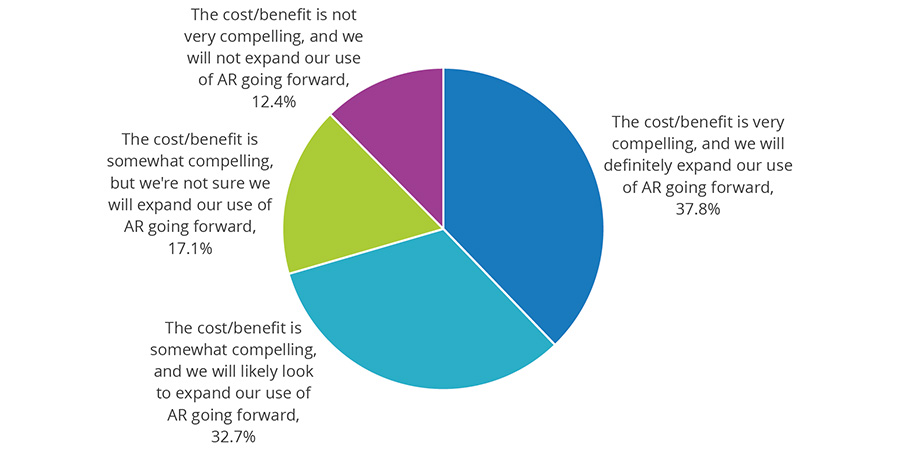How Augmented Reality Adoption in Manufacturing Is Transforming Processes
State of augmented reality adoption in manufacturing today
The high cost of change has meant that discrete manufacturing as an industry has not always embraced cutting-edge technology, but that’s changing today as many manufacturers explore the use of augmented reality (AR) to address challenges around aging/retiring workforces, issues around attracting and retaining new talent, and the difficulty of training new hires on increasingly complex machines and processes. AR, a visualization technology that uses computer vision software running on smartphones, tablets, and headsets to “augment” a worker’s environment, can help manufacturers to modernize and streamline processes, eliminate costly errors, and reduce downtime by making it possible to digitize existing work instructions and create AR work instructions to visually guide front-line workers.
While many companies are trimming overall budgets in light of the current economic headwinds, IDC sees manufacturers ramping up investments in AR technologies. In fact, IDC’s most recent AR/VR Spending Guide showed that worldwide spending on AR software in the discrete manufacturing sector is set to grow from $210 million in 2022 to $716 million by 2026. Smart companies are investing in AR because they know that well-planned AR deployments can address a wide range of challenges across a breadth of use cases.
Manufacturing and service-focused use cases
End-of-line inspection
End-of-line inspection is a key AR use case in discrete manufacturing that’s especially important among tier 1 automotive suppliers. AR can help eliminate slow, error-prone paper-based processes by bringing real-time data to the inspection process, viewable on a connected smartphone, tablet, or headset. AR helps eliminate human errors, improve the quality of the final product, and as a direct result, reduce the number of returns and avoid recalls.
Component location and service instructions
Component location and service instructions need to be clear and precise when working on automobiles and heavy equipment. When they aren’t, it can be a major time sink for the technician with downstream impacts on customer satisfaction. Leveraging existing back-end systems of record as well as an organization’s current digital asset repositories, AR can significantly reduce search times as well as deliver the right instructions to employees when and where they need them. As a result, organizations can significantly increase first-time fix rates while simultaneously improving the overall service quality.
Machine operation
Machine operation continues to be a pain point for manufacturers of all types and can be especially tough for machine builders and those dealing with industrial equipment. As firms wrestle with increasingly complex equipment while also struggling to acquire new talent, many have turned to AR technologies to address the challenges. Working with trusted AR partners can simplify the creation and delivery of digital instructions, all in the service of avoiding costly errors and downtime.
Customer self-service
Customer self-service is a key focus for many discrete manufacturers that are looking to limit the costs associated with supporting their customers after the delivery of a product. Forward-thinking companies can drive a better experience for their customers by leveraging their existing digital assets—from CAD drawings to marketing materials—to build out a product-specific self-service model at the beginning of the engagement. By empowering your customers to address their own onboarding and digital instruction requirements, you can drive increases in efficiency, and lower overall costs, while also improving your customer’s satisfaction. Moreover, a good AR program can help eliminate or reduce the need for travel when it comes to long-term operation, maintenance, or repair.
Product familiarization
Product familiarization remains a key challenge for discrete manufacturers as product lines continue to expand, individual products become more complex, and companies ship to a wider range of geographies. Smart companies are using AR technologies to create digital assets that can enhance learning around new products to increase employee retention in terms of sales, marketing, and operation. Companies are also using the technology to create assets that accelerate the onboarding of new talent.
IDC survey shows strong ROI among current AR adopters
If you’re new to the AR technology space, you might think all these benefits are a little too good to be true. But business leaders, decision makers, and mainstream markets are already adopting AR and reaping the benefits. IDC’s ongoing surveys of IT decision makers (ITDMs) inside companies that have adopted AR point to a long list of benefits, plus a clear return on investment. The top benefits cited in our 2022 study: Increased worker efficiency, improved design and manufacturing processes, improved training results, and improved knowledge transfer between expert and novice workers.
There are other benefits as well. Among those current adopters that went the extra mile to track the cost/benefit of AR, more than 70% found the results compelling enough to make plans to expand their use of the technology in the future (see Figure 1).
Figure 1
Q You said you are familiar with the result of your company’s study of the cost benefit analysis of AR technologies. How would you characterize the finding?

Source: IDC, 2023
Don’t fall behind, explore AR today
The discrete manufacturing industry continues to face a long list of challenges, including a tough macroeconomic environment, ongoing issues with talent acquisition and retention, growing product complexity, and more. Successful manufacturers are addressing these challenges head-on through the embrace of new technologies such as AR. By partnering with the right software providers, these firms are tackling challenges around end-of-line inspection, parts and instructions, machine operation, customer self-service, and product familiarization.